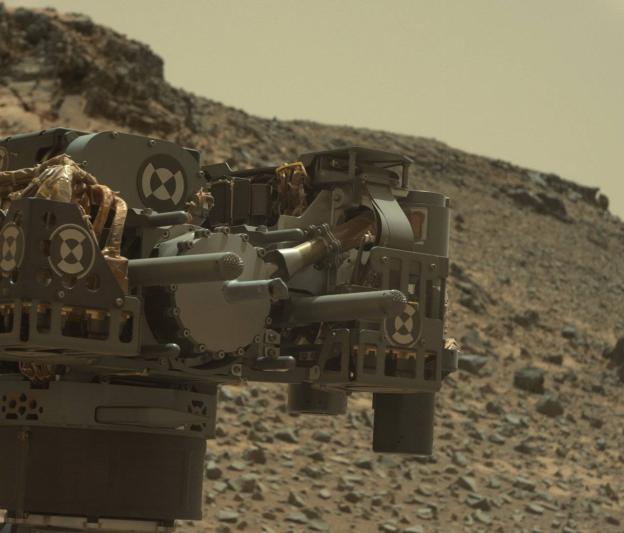
A short circuit that halted movement of NASA’s Curiosity Mars rover is not expected to keep the mobile robot stationary for long, but engineers want to know whether the problem will restrict some future science operations.
The rover’s on-board fault-protection software detected a problem in Curiosity’s electrical circuitry Feb. 27, stopping a procedure to transfer a Martian soil sample between devices on the platform’s robotic arm.
NASA officials said the software responded to the glitch as designed.
“We are running tests on the vehicle in its present configuration before we move the arm or drive,” said Jim Erickson, Curiosity’s project manager at NASA’s Jet Propulsion Laboratory, in a statement released Tuesday. “This gives us the best opportunity to determine where the short is.”
Curiosity is at the base of a three-mile-high peak named Mount Sharp, where the rover is studying sediments that scientists believe were deposited when Mars was warmer, wetter and habitable by microbial life.
Since landing on Mars in August 2012, the rover has already achieved its primary mission goals after finding its landing site in Gale crater once contained an ancient river system, where simple organisms could have survived billions of years ago.
The rover’s drill mounted on the end of the robotic arm collected a sample from a rock last month, and Curiosity was taking initial steps to transfer rock powder from the drill to a miniature laboratory cocooned inside the craft’s body.

Curiosity collected five samples with the drill earlier in its mission without incident.
Engineers are performing tests on the rover to determine where the short occurred — whether it was somewhere inside the drill system or elsewhere on the rover, Erickson told CBS News.
“In looking at the initial diagnostics that we are doing and what the possible root causes are, nothing shows up as a show stopper,” Erickson said in an interview with CBS News. “We could be surprised, and that’s one of the reasons we’re doing more analysis and looking at all the data we’re getting down. We’re going to start out very gentle, so to speak, and very low risk and gradually move to where the data shows us we should be moving.”
Curiosity will stay stationary while engineers complete their analysis of the trigger that halted the rover’s sampling operation last week. Erickson said ground controllers plan to finish preparing the rock powder for delivery to Curiosity’s internal instruments once engineers give the all-clear.
“A transient short in some systems on the rover would have little effect on rover operations,” NASA said in a press release. “In others, it could prompt the rover team to restrict use of a mechanism.”
Follow Stephen Clark on Twitter: @StephenClark1.



